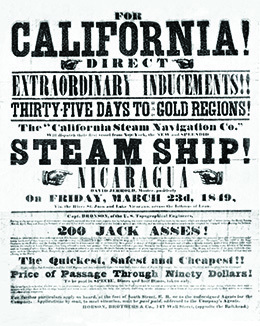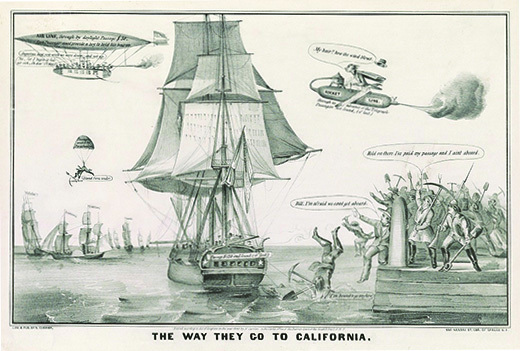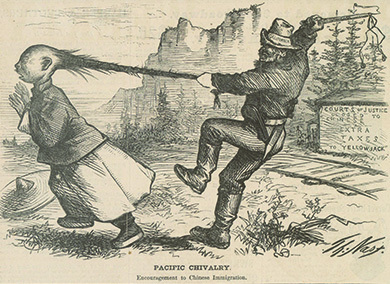| << Chapter < Page | Chapter >> Page > |

The fantasy of instant wealth induced a mass exodus to California. Settlers in Oregon and Utah rushed to the American River. Easterners sailed around the southern tip of South America or to Panama’s Atlantic coast, where they crossed the Isthmus of Panama to the Pacific and booked ship’s passage for San Francisco. As California-bound vessels stopped in South American ports to take on food and fresh water, hundreds of Peruvians and Chileans streamed aboard. Easterners who could not afford to sail to California crossed the continent on foot, on horseback, or in wagons. Others journeyed from as far away as Hawaii and Europe. Chinese people came as well, adding to the polyglot population in the California boomtowns ( [link] ).

Once in California, gathered in camps with names like Drunkard’s Bar, Angel’s Camp, Gouge Eye, and Whiskeytown, the “ forty-niners ” did not find wealth so easy to come by as they had first imagined. Although some were able to find gold by panning for it or shoveling soil from river bottoms into sieve-like contraptions called rockers, most did not. The placer gold, the gold that had been washed down the mountains into streams and rivers, was quickly exhausted, and what remained was deep below ground. Independent miners were supplanted by companies that could afford not only to purchase hydraulic mining technology but also to hire laborers to work the hills. The frustration of many a miner was expressed in the words of Sullivan Osborne. In 1857, Osborne wrote that he had arrived in California “full of high hopes and bright anticipations of the future” only to find his dreams “have long since perished.” Although $550 million worth of gold was found in California between 1849 and 1850, very little of it went to individuals.
Observers in the gold fields also reported abuse of Indians by miners. Some miners forced Indians to work their claims for them; others drove Indians off their lands, stole from them, and even murdered them. Foreigners were generally disliked, especially those from South America. The most despised, however, were the thousands of Chinese migrants. Eager to earn money to send to their families in Hong Kong and southern China, they quickly earned a reputation as frugal men and hard workers who routinely took over diggings others had abandoned as worthless and worked them until every scrap of gold had been found. Many American miners, often spendthrifts, resented their presence and discriminated against them, believing the Chinese, who represented about 8 percent of the nearly 300,000 who arrived, were depriving them of the opportunity to make a living.
Visit The Chinese in California to learn more about the experience of Chinese migrants who came to California in the Gold Rush era.
In 1850, California imposed a tax on foreign miners, and in 1858 it prohibited all immigration from China. Those Chinese who remained in the face of the growing hostility were often beaten and killed, and some Westerners made a sport of cutting off Chinese men’s queues, the long braids of hair worn down their backs ( [link] ). In 1882, Congress took up the power to restrict immigration by banning the further immigration of Chinese.

As people flocked to California in 1849, the population of the new territory swelled from a few thousand to about 100,000. The new arrivals quickly organized themselves into communities, and the trappings of “civilized” life—stores, saloons, libraries, stage lines, and fraternal lodges—began to appear. Newspapers were established, and musicians, singers, and acting companies arrived to entertain the gold seekers. The epitome of these Gold Rush boomtowns was San Francisco, which counted only a few hundred residents in 1846 but by 1850 had reached a population of thirty-four thousand ( [link] ). So quickly did the territory grow that by 1850 California was ready to enter the Union as a state. When it sought admission, however, the issue of slavery expansion and sectional tensions emerged once again.

President James K. Polk’s administration was a period of intensive expansion for the United States. After overseeing the final details regarding the annexation of Texas from Mexico, Polk negotiated a peaceful settlement with Great Britain regarding ownership of the Oregon Country, which brought the United States what are now the states of Washington and Oregon. The acquisition of additional lands from Mexico, a country many in the United States perceived as weak and inferior, was not so bloodless. The Mexican Cession added nearly half of Mexico’s territory to the United States, including New Mexico and California, and established the U.S.-Mexico border at the Rio Grande. The California Gold Rush rapidly expanded the population of the new territory, but also prompted concerns over immigration, especially from China.

Notification Switch
Would you like to follow the 'U.s. history' conversation and receive update notifications?